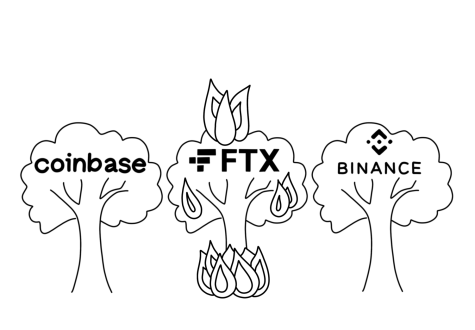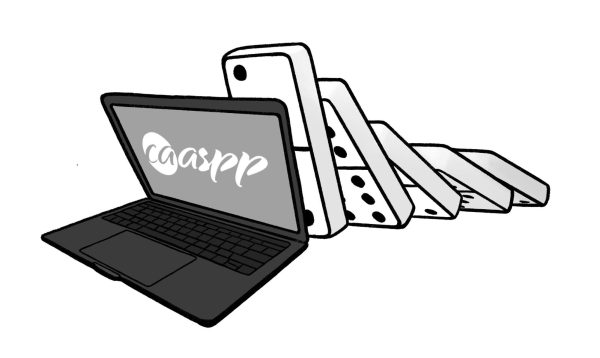Lessons from the FTX crash
December 7, 2022
FTX and over 100 companies associated with them have filed for bankruptcy. Billions of dollars have been lost. So, what could be the lesson in this mess? It boils down to crypto not being used the way it should be. First, some background knowledge on the FTX and how it crashed.
FTX was the world’s second-largest crypto exchange. It was run by Sam Bankman-Fried (SBF) and initially rose to power due to its enticing financial features and lack of regulation. SBF then switched his tone and called for crypto regulation. Binance, the largest crypto exchange in the world, didn’t like that SBF was taking actions which would hurt other players in the industry. In particular, calling for more regulation would hurt the liberty and bottom line of other exchanges in the space. In retaliation for proposing regulation, the Chief Executive Officer (CEO) of Binance, Changpeng Zhao — commonly known as CZ — delisted FTX’s proprietary token from Binance, putting a lot of downward pressure on the token and sending the price plummeting. Congruently, there were rumors FTX had insufficient funds.

Many FTX investors were overwhelmed by the spectacle and attempted to withdraw their funds. This led to FTX halting withdrawals, leading to a bank run. A bank run is where investors try to pull their funds out of an entity all at the same time testing an entity’s reserves. CZ offered to buy FTX, SBF agreed and a deal was about to go through. Last minute, CZ pulled out of the deal after inspecting FTX’s books and realizing something was wrong; it turned out that FTX had no records and no funds. They were selling people Bitcoin that didn’t exist. SBF had created a backdoor that allowed him to pull billions out of FTX without alerting anyone. While FTX was crashing their executives were stealing money from their own exchange.
To make a long story short, FTX and many of its associates have gone bankrupt. SBF had been using the money from FTX to buy luxury real estate in the Bahamas and fund his venture capital fund, Alameda Ventures, which his financially inept ex-girlfriend ran. I highly recommend reading more about FTX’s fall; there is theft, corruption, connections to the Securities and Exchange Commission (SEC) and President Joe Biden, backstabbing, possible pedophilia, a sex tape and a murder.
Despite all the noise, if investors used crypto how it was meant to be used, none of this would have happened. A centralized crypto exchange is an oxymoron — crypto is designed to be decentralized. Crypto falls under the umbrella of decentralized finance, commonly shortened to DeFi. Thus, crypto is largely unregulated, and people should treat it that way.The Federal Deposit Insurance Corporation (FDIC) even put out a statement warning people about their agency’s lack of association with crypto, writing, “The FDIC does not insure any cryptocurrency exchanges; FDIC insurance does not cover cryptocurrency; the FDIC only insures deposits held in insured banks and savings associations (insured institutions), and FDIC insurance only protects against losses caused by the failure of insured institutions.” The above statement explains that the government will not help people get their money back if they lose it on a crypto exchange. Keeping crypto on an exchange like FTX creates more risk for investors, not less.
The opposition may suggest that crypto exchanges are convenient because one can log into them and access their crypto with a short password instead of a long seed phrase. A short password and convenience seems like a great deal but not at the expense of someone’s entire crypto portfolio. People need to stop trying to make crypto something it’s not. Crypto is decentralized. Crypto emphasizes personal responsibility. Those who don’t like it can return to fiat currency and traditional finance. Storing crypto in exchange is like when a kid gives their birthday money to their mom for “safe keeping” — they won’t see it again.
Some may be wondering where they should store their crypto. There are two options. There are digital software wallets such as Metamask, allowing users to store their keys separately while conveniently keeping their wallet digital. The even safer option is a hardware wallet. A hardware wallet is an encrypted flash drive which holds your keys for you behind a password. Today’s industry standard is the Ledger Nano X. Additionally, a seed phrase is like any password: Remember never to share your seed phrase with anyone or take a picture of it.
The FTX crash is a prime example of why crypto should remain decentralized, given the fraud and theft witnessed in this event. Centralizing crypto leads to the fraud and theft seen in the FTX crash. This is a community effort, and future centralized crypto institutions must be rejected.





















